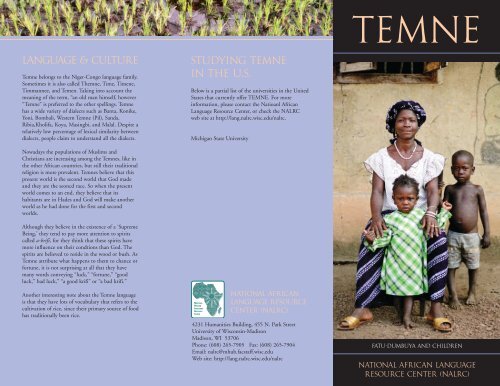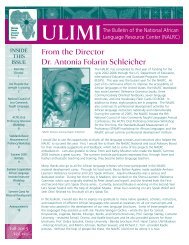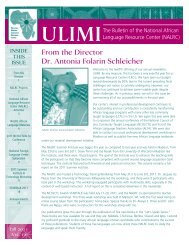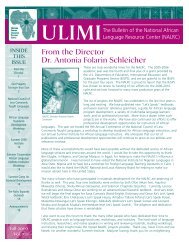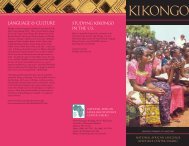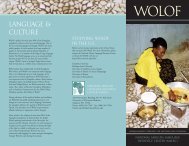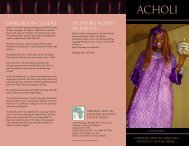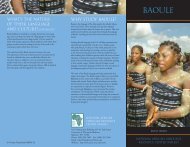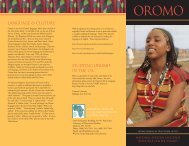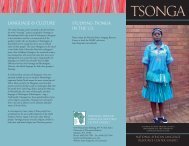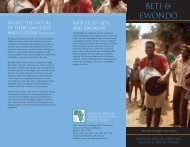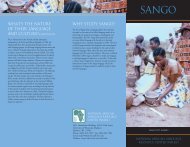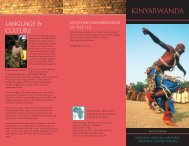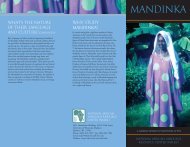Temne - National African Language Resource Center
Temne - National African Language Resource Center
Temne - National African Language Resource Center
You also want an ePaper? Increase the reach of your titles
YUMPU automatically turns print PDFs into web optimized ePapers that Google loves.
LANGUAGE & CULTURE<br />
<strong>Temne</strong> belongs to the Niger-Congo language family.<br />
Sometimes it is also called Themne, Time, Timene,<br />
Timmannee, and Temen. Taking into account the<br />
meaning of the term, “an old man himself, however<br />
“<strong>Temne</strong>” is preferred to the other spellings. <strong>Temne</strong><br />
has a wide variety of dialects such as Banta, Konike,<br />
Yoni, Bombali, Western <strong>Temne</strong> (Pil), Sanda,<br />
Ribia,Kholifa, Koya, Masingbi, and Malal. Despite a<br />
relatively low percentage of lexical similarity between<br />
dialects, people claim to understand all the dialects.<br />
Nowadays the populations of Muslims and<br />
Christians are increasing among the <strong>Temne</strong>s, like in<br />
the other <strong>African</strong> countries, but still their traditional<br />
religion is more prevalent. <strong>Temne</strong>s believe that this<br />
present world is the second world that God made<br />
and they are the seoncd race. So when the present<br />
world comes to an end, they believe that its<br />
habitants are in Hades and God will make another<br />
world as he had done for the first and second<br />
worlds.<br />
Although they believe in the existence of a ‘Supreme<br />
Being,’ they tend to pay more attention to spirits<br />
called a-krifi, for they think that these spirits have<br />
more influence on their condtions than God. The<br />
spirits are believed to reside in the wood or bush. As<br />
<strong>Temne</strong> attribute what happens to them to chance or<br />
fortune, it is not surprising at all that they have<br />
many words conveying “luck,” “fortune,” “good<br />
luck,” bad luck,” “a good krifi” or “a bad krifi.”<br />
Another interesting note about the <strong>Temne</strong> language<br />
is that they have lots of vocubulary that refers to the<br />
cultivation of rice, since their primary source of food<br />
has traditionally been rice.<br />
STUDYING TEMNE<br />
IN THE U.S.<br />
Below is a partial list of the universities in the United<br />
States that currently offer TEMNE. For more<br />
information, please contact the Natioanl <strong>African</strong><br />
<strong>Language</strong> <strong>Resource</strong> <strong>Center</strong>, or check the NALRC<br />
web site at http://lang.nalrc.wisc.edu/nalrc.<br />
Michigan State University<br />
<strong>National</strong> <strong>African</strong><br />
<strong>Language</strong> <strong>Resource</strong><br />
<strong>Center</strong> (NALRC)<br />
4231 Humanities Building, 455 N. Park Street<br />
University of Wisconsin-Madison<br />
Madison, WI 53706<br />
Phone: (608) 265-7905 Fax: (608) 265-7904<br />
Email: nalrc@mhub.facstaff.wisc.edu<br />
Web site: http://lang.nalrc.wisc.edu/nalrc<br />
<strong>Temne</strong><br />
FATU-DUMBUYA AND CHILDREN<br />
<strong>National</strong> <strong>African</strong> <strong>Language</strong><br />
<strong>Resource</strong> <strong>Center</strong> (NALRC)
WHY STUDY TEMNE?<br />
<strong>Temne</strong> means “an old man himself,” and it reflects the<br />
<strong>Temne</strong> people’s belief that their nation will exist<br />
forever. <strong>Temne</strong> is one of the four official languages of<br />
Sierra Leone and it is also used as a lingua franca in<br />
predominantly <strong>Temne</strong>-speaking areas, nothern half of<br />
Sierra Leone. Speakers who use <strong>Temne</strong> as their first<br />
language compose almost 30% of Sierra Leone<br />
population and its second language users are estimated<br />
240,0000. Furthermore, you can hear radio broadcasts<br />
in <strong>Temne</strong> in Sierra Leone everyday. This means that<br />
without the knowledge of <strong>Temne</strong>, you could not<br />
communicate with people in northen province of<br />
Sierra Leone.<br />
<strong>Temne</strong> will be an interesting research area for linguistic<br />
reseachers as well. Because the <strong>Temne</strong> are surrounded<br />
by moutains, its language has unique characteristics<br />
from other neighboring languages. For example, the<br />
article is a distinguishing feature of <strong>Temne</strong>. As in<br />
English, <strong>Temne</strong> has definite and indefinite articles but<br />
where they are inserted is not congrous to English. It is<br />
prefixed to adjectives and to some pronouns as well as<br />
to nouns. That is, proper use of the article in <strong>Temne</strong> is<br />
to form nouns and adjectives from verbs, and to point<br />
out the definite and indefinite status of nouns,<br />
adjectives, and some pronouns. In addtion to the use<br />
of articles, other factors of the <strong>Temne</strong> language might<br />
be challenging as well for linguists to explore.<br />
<strong>Temne</strong> will also be useful for those who would like to<br />
learn about <strong>Temne</strong> culture. The <strong>Temne</strong> are proud of<br />
their long lasting culture. One of the fascinating facets<br />
of the <strong>Temne</strong> culture is the <strong>Temne</strong> mask. They have<br />
developed their own mask culture, which is as famous<br />
as Mende masks. They have strong oral tradition of<br />
narrative and proverbs. <strong>Temne</strong> will be a good vehicle<br />
through which people can get access to these rich<br />
traditions of <strong>Temne</strong>.<br />
WHO SPEAKS TEMNE?<br />
PEOPLE AND HISTORY<br />
Early history of Sierra Leone is very unclear, but the<br />
most widely known fact is that most ethnic groups<br />
including <strong>Temne</strong> came to the easten coast of Africa in<br />
the 1400’s. Around 1400, the first Mende people<br />
immigrated to Sierra Leone. In 1540, it is estimated<br />
that <strong>Temne</strong> followed the immigration of Mende and<br />
settled down in the northern part of Sierra Leone.<br />
Farma Tami was regarded by the <strong>Temne</strong> both as a<br />
great warrior and as the founder of their civilization.<br />
According to tradition, he is said to have organized<br />
the <strong>Temne</strong> into strong kingdoms and established<br />
their importance all over the country. Farma Tami<br />
came from the east with a great army, and conquered<br />
all opposition until he reached the estuary of the<br />
Rokel River. He established his capital at the town of<br />
Robaga, near modern Freetown. <strong>Temne</strong> elders still<br />
recall that Farma taught people the art of war even<br />
when there was no gun, and they still regard the<br />
town of Robaga as a sacred place. Indeed, every<br />
important chief must make a pilgrimage to Robaga<br />
and the shrine of great Farma Tami.<br />
In the late 15th century, European ships started to<br />
visit the coast regularly to trade manufactured goods<br />
for slaves and ivory. In 1787, 331 <strong>African</strong>s and 46<br />
Europeans arrived in Sierra Leone, acquired land<br />
from <strong>Temne</strong> regent, King Tom, and established<br />
“Province of Freedom.” Through the efforts of British<br />
abolitionists and philanthropists, the Province of<br />
Freedom was renamed as Freetown and was<br />
established for freed and runaway slaves. In 1896, as<br />
the British power increased over the Sierra Leone,<br />
most parts were proclaimed British protectorate.<br />
Sierra Leone gained independence in 1961, but its<br />
modern history is consecutive civil wars. Up to 2002,<br />
two civil governments and six military goverments<br />
had been established and overthrown. In 2002, a<br />
peace agreement between the government and<br />
Revolutionary United Front (RUF) ended the longlasting<br />
civil conflict. And now over 16,000 peacekeeping<br />
people sent by the United Nations are<br />
helping to rebuild Sierra Leone.<br />
Paramount Chief of Kambai.<br />
A <strong>Temne</strong> animal mask. Street trader and friend.<br />
A <strong>Temne</strong> man is planting rice.


